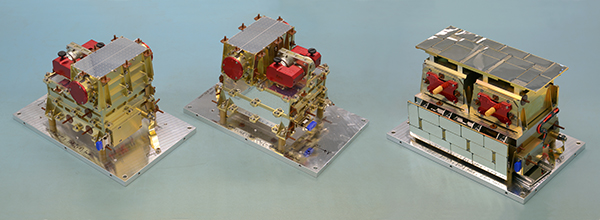Countdown to the space mission “Solar Orbiter”: Measuring instruments from Kiel start their voyage

The three sensors from Kiel are ready for space: EPT-HET1 and 2 on the left, and STEP on the right. Photo/Copyright: Jürgen Haacks, CAU
Instruments on board a space probe must be able to withstand large temperature variations, intense vibrations during the launch of the rocket or voltage surges, without their functionality being affected.
In order to ensure this, scientists at the Institute of Experimental and Applied Physics subjected their instruments to extensive tests. Representatives of ESA assessed the results just over two weeks ago, and after a few subsequent improvements, finally certified the solar particle sensors from Kiel for use in space. “Our sensors have passed the tests with flying colours!” said a delighted Wimmer-Schweingruber.
“The instruments have been approved. On Monday, our team will personally deliver them to England. It is especially thanks to our excellent team that we have successfully met the tight deadline!”
A total of four instruments will be installed in the “Energetic Particle Detector” (EPD) on board the space probe. The sensors measure electrons, protons and ions of all the particles in space, from helium nuclei right through to iron nuclei.
They must cover a particularly wide energy range, from approximately 2 kiloelectronvolts up to 200 megaelectronvolts. The results of these measurements will help to better understand sun particle radiation and its effect on the earth.
Photos are available to download:
http://www.uni-kiel.de/download/pm/2016/2016-386-1.jpg
The three sensors from Kiel are ready for space: EPT-HET1 and 2 on the left, and STEP on the right.
Photo/Copyright: Jürgen Haacks, CAU
http://www.uni-kiel.de/download/pm/2016/2016-386-2.jpg
Close-up of the two-in-one-sensor EPT-HET (left), which measures in two directions. STEP (right): due to the magnetic field in the sensor, the installation position in the space probe was changed on the fly during the development process, as there were fears that it could affect other instruments. In spite of the tight deadline, the team from Kiel managed to modify their instrument on time for its new position.
Photo/Copyright: Jürgen Haacks, CAU
http://www.uni-kiel.de/download/pm/2016/2016-386-3.jpg
Experts, including representatives of the ESA, closely examined the test results and the sensors from Kiel on 3 November.
Photo/Copyright: Jürgen Haacks, CAU
http://www.uni-kiel.de/download/pm/2016/2016-386-4.jpg
The team from Kiel delivers: their sensors will be installed in the Solar Orbiter space probe.
Photo/Copyright: Jürgen Haacks, CAU
Background information
In addition to a team of engineers, there are also scientists, doctoral candidates and students from Kiel University involved in the EPD projects. They work together in an international team, with members from Spain, Germany and the USA. Among the total of four instruments in the “Energetic Particle Detector” (EPD) are an Instrument Control Unit (ICU) and the SupraThermal Ion Spectrograph (SIS). This SIS will undertake particle measurements during the voyage to the sun, in an energy range from around 100 kiloelectronvolts to 10 megaelectronvolts. The sensor was developed at the Johns Hopkins University Applied Physics Laboratory (APL) under the leadership of Professor Wimmer-Schweingruber.
Three sensors were developed in the Kiel physics cleanroom:
The STEP (Supra Thermal Electrons and Protons) sensor measures in the energy range from 2.5 to 65 kiloelectronvolts. If there is an influx of particles in this range, electrons are deflected by means of a magnetic field on the one side of the instrument. Only protons and ions are measured here. On the other side of the instrument, without a magnetic field, the entire flow of particles in the relevant energy range is measured. The difference between the two sides allows determination of the electrons present.
The EPT-HET1 and 2 instruments are identical, and each contain two sensors: EPT (Electron and Proton Telescope) and HET (High-Energy Telescope) sensors. Together they measure electrons in the energy range from 20 kiloelectronvolts to 20 megaelectronvolts, as well as protons from 20 kiloelectronvolts to 100 megaelectronvolts. The HET also measures heavy ions up to 200 megaelectronvolts. The EPT-HET1 and EPT-HET2 instruments can each measure in two directions (sun-facing side / dark side or alternatively prograde / retrograde relative to orbit).
The Kiel projects are funded by the DLR Space Agency, and the SIS is funded by the ESA.
More information:
http://www.physik.uni-kiel.de/de/institute/ieap/ag-wimmer/solo
Contact:
Prof. Robert Wimmer-Schweingruber
Institute of Experimental and Applied Physics
Kiel University
E-mail: wimmer@physik.uni-kiel.de
Mobile number: +49 173 951 3332
Kiel University
Press, Communication and Marketing, Dr Boris Pawlowski, Text: Claudia Eulitz
Postal address: D-24098 Kiel, Germany,
Telephone: +49 (0)431 880-2104, Fax: +49 (0)431 880-1355
E-mail: presse@uv.uni-kiel.de, Internet: www.uni-kiel.de, Twitter: www.twitter.com/kieluni Facebook: www.facebook.com/kieluni, Instagram: instagram.com/kieluni
http://www.uni-kiel.de/pressemeldungen/index.php?pmid=2016-386-solar-orbiter&…
Media Contact
All latest news from the category: Physics and Astronomy
This area deals with the fundamental laws and building blocks of nature and how they interact, the properties and the behavior of matter, and research into space and time and their structures.
innovations-report provides in-depth reports and articles on subjects such as astrophysics, laser technologies, nuclear, quantum, particle and solid-state physics, nanotechnologies, planetary research and findings (Mars, Venus) and developments related to the Hubble Telescope.
Newest articles

Properties of new materials for microchips
… can now be measured well. Reseachers of Delft University of Technology demonstrated measuring performance properties of ultrathin silicon membranes. Making ever smaller and more powerful chips requires new ultrathin…

Floating solar’s potential
… to support sustainable development by addressing climate, water, and energy goals holistically. A new study published this week in Nature Energy raises the potential for floating solar photovoltaics (FPV)…

Skyrmions move at record speeds
… a step towards the computing of the future. An international research team led by scientists from the CNRS1 has discovered that the magnetic nanobubbles2 known as skyrmions can be…





















